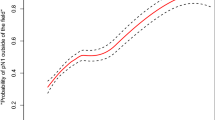Abstract
Introduction
In renal cell carcinoma (RCC), lymph node status at preoperative imaging is affected by a non-negligible false-positive rate. We aimed to investigate which factors are related to a concordance between clinical suspicion and pathological confirmation of lymph node invasion (LNI).
Methods
At a single tertiary care institution, 2954 RCC patients underwent either partial or radical nephrectomy. For the aim of the study, only clinically positive lymph node cases were included (cN1). Statistical analyses assessed the concordance between preoperative and pathological nodal status.
Results
Preoperative axial CT scans revealed 424 (14.4 %) patients showing at least one enlarged lymph node suspected for LNI (cN1). All lymphadenopathies were removed at surgery, and LNI was pathologically confirmed (pN1) in 122 patients (28.8 %). When focusing the analyses on clinical characteristics (variables known before surgery), metastases at diagnosis [OR 3.0 (95 %1.9–4.8), p < 0.001] and tumor size [OR 1.1 (95 % 1.1–1.2), p < 0.001] were the two most informative predictors of concordance between clinical and pathological nodal status. Concordance was also more likely in patients with papillary type II tumors (55.6 %) relative to papillary type I (38.1 %), clear cell (27.7 %) and chromophobe (8.3 %) tumors. At multivariable analyses, none of the considered blood markers resulted to be independently associated with LNI.
Conclusions
Roughly 70 % of patients showing a suspected lymph node preoperatively do not show LNI at the final pathological report. Among patients with clinically positive nodes, clinical tumor size and metastases at diagnosis represent the most informative and independent predictors of confirmed LNI at final pathology.



Similar content being viewed by others
References
Network NCC (2015) NCCN clinical practice guidelines in kidney cancer. 12 Sept 2014: Version 3.2015
Ljungberg B, Bensalah K, Canfield S, Dabestani S, Hofmann F, Hora M, Kuczyk MA, Lam T, Marconi L, Merseburger AS, Mulders P, Powles T, Staehler M, Volpe A, Bex A (2015) EAU guidelines on renal cell carcinoma: 2014 update. Eur Urol 67(5):913–924. doi: 10.1016/j.eururo.2015.01.005
Capitanio U, Montorsi F (2015) Renal cancer. Lancet. doi: 10.1016/S0140-6736(15)00046-X
Briganti A, Abdollah F, Nini A et al (2012) Performance characteristics of computed tomography in detecting lymph node metastases in contemporary patients with prostate cancer treated with extended pelvic lymph node dissection. Eur Urol 61:1132–1138
Studer UE, Scherz S, Scheidegger J et al (1990) Enlargement of regional lymph nodes in renal cell carcinoma is often not due to metastases. J Urol 144:243–245
Capitanio U, Becker F, Blute ML et al (2011) Lymph node dissection in renal cell carcinoma. Eur Urol 60:1212–1220
Ljungberg B, Cowan NC, Hanbury DC et al (2010) EAU guidelines on renal cell carcinoma: the 2010 update. Eur Urol 58:398–406
Harrell FE Jr, Califf RM, Pryor DB, Lee KL, Rosati RA (1982) Evaluating the yield of medical tests. JAMA 14(247):2543–2546
Harrell FE Jr, Lee KL, Mark DB (1996) Multivariable prognostic models: issues in developing models, evaluating assumptions and adequacy, and measuring and reducing errors. Stat Med 28(15):361–387
Connolly SS, Raja A, Stunell H et al (2015) Diagnostic accuracy of preoperative computed tomography used alone to detect lymph-node involvement at radical nephrectomy. Scand J Urol 49:142–148
Pushkar P, Agarwal A, Sarin A, Kashyap V (2015) Concurrent RCC with tuberculous para-aortic lymphadenopathy: a pleasant surprise. Can Urol Assoc J 9:E210-2
Lughezzani G, Capitanio U, Jeldres C, Isbarn H, Shariat SF, Arjane P, Widmer H, Perrotte P, Montorsi F, Karakiewicz PI (2009) Prognostic significance of lymph node invasion in patients with metastatic renal cell carcinoma: a population-based perspective. Cancer 115(24):5680–5687. doi: 10.1002/cncr.24682
Kates M, Lavery HJ, Brajtbord J, Samadi D, Palese MA (2012) Decreasing rates of lymph node dissection during radical nephrectomy for renal cell carcinoma. Ann Surg Oncol 19(8):2693–2699. doi: 10.1245/s10434-012-2330-6
Blom JH, van Poppel H, Marechal JM et al (2009) Radical nephrectomy with and without lymph-node dissection: final results of European Organization for Research and Treatment of Cancer (EORTC) randomized phase 3 trial 30881. Eur Urol 55:28–34
Capitanio U, Suardi N, Matloob R et al (2014) Extent of lymph node dissection at nephrectomy affects cancer-specific survival and metastatic progression in specific sub-categories of patients with renal cell carcinoma (RCC). BJU Int 114:210–215
Whitson JM, Harris CR, Reese AC, Meng MV (2011) Lymphadenectomy improves survival of patients with renal cell carcinoma and nodal metastases. J Urol 185:1615–1620
Capitanio U, Becker F, Blute ML, Mulders P, Patard JJ, Russo P, Studer UE, Van Poppel H (2011) Lymph node dissection in renal cell carcinoma. Eur Urol 60(6):1212–1220. doi: 10.1016/j.eururo.2011.09.003
Kroeger N et al (2012) Clinical, molecular, and genetic correlates of lymphatic spread in clear cell renal cell carcinoma. Eur Urol 61(5):888–895
Eisenhauer EA, Therasse P, Bogaerts J et al (2009) New response evaluation criteria in solid tumours: revised RECIST guideline (version 1.1). Eur J Cancer 45:228–247
Authors’ contribution
Capitanio, Deho’, Dell’Oglio, Larcher, Capogrosso, Nini, Briganti and Bertini involved in protocol/project development. Capitanio, Deho’, Dell’Oglio, Larcher, Capogrosso, Nini, Carenzi, Freschi, Montorsi and Bertini involved in data collection or management. Capitanio, Dell’Oglio, Larcher, Nini and Carenzi involved in data analysis. Capitanio, Deho’, Dell’Oglio, Larcher, Capogrosso, Nini, Carenzi, Freschi, Briganti, Salonia, Montorsi and Bertini wrote and edited the manuscript.
Author information
Authors and Affiliations
Corresponding author
Ethics declarations
Conflict of interest
None.
Ethical standards
There are no financial or non-financial conflicts; informed consent was collected from the patients; animals were not involved.
Rights and permissions
About this article
Cite this article
Capitanio, U., Deho’, F., Dell’Oglio, P. et al. Lymphadenopathies in patients with renal cell carcinoma: clinical and pathological predictors of pathologically confirmed lymph node invasion. World J Urol 34, 1139–1145 (2016). https://doi.org/10.1007/s00345-015-1747-5
Received:
Accepted:
Published:
Issue Date:
DOI: https://doi.org/10.1007/s00345-015-1747-5




